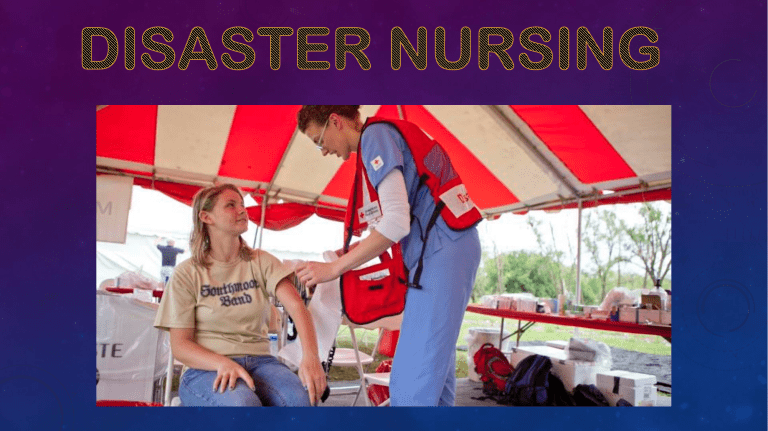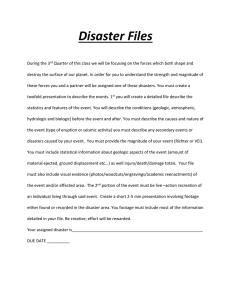
OVERVIEW OF DISASTER NURSING AND EMERGENCY PREPAREDNESS An EMERGENCY is a sudden, urgent, unexpected event requiring immediate action, usually requiring help. Sufficient RESOURCES ARE AVAILABLE to deal with it. A DISASTER is a calamitous event, especially one occurring suddenly and causing great loss of life, damage, or hardship. Sufficient RESOURCES ARE NOT AVAILABLE or SCARCE. BASED ON RA 10121 EMERGENCY- Unforeseen or sudden occurrence, especially danger, demanding immediate action (RA 10121). DISASTER- A serious disruption of the functioning of a community or a society involving widespread human, material, economic or environmental losses and impacts, which exceeds the ability of the affected community or society to cope using its own resources. (RA 10121). How is a disaster the same as or different from an emergency? a. A disaster is personal, whereas an emergency is community-wide. b. An emergency is personal, whereas a disaster is community-wide. c. Both emergencies and disasters are devastating. d. Both emergencies and disasters are failures resulting in extensive insurance claims. HAZARDS-A dangerous phenomenon, substance, human activity or condition that may cause loss of life, injury or other health impacts, property damage, loss of livelihood and services, social and economic disruption or environmental damage (RA 10121) RISK-This is defined as the combination of the PROBABILITY of an event and its negative consequences (RA 10121). HISTORICAL PERSPECTIVE OF DISASTER NURSING Florence Nightingale, the pioneer of modern nursing, functioned as a disaster nurse during the Crimean War. Taking 38 other women with her to Turkey, she assumed the management responsibilities of the barracks hospital. “The Lady With the Lamp” Clara Barton, another pioneering nurse, worked diligently during the Civil War providing care to soldiers and then founded the American Red Cross in 1881. Barton had a keen understanding of the needs of the soldiers and what she could do to help. She came to be known as “The angel of the battlefield.” BASIC PRINCIPLES IN PLANNING FOR DISASTER NURSING N- ursing plans must be integrated & coordinated U- pdated physical and psychological preparedness R- esponsible for organizing, teaching & supervision S- timulate community participation E- xercise competence BASIC PRINCIPLES OF NURSING CARE FOR DISASTER VICTIMS ADAPTATION OF NURSING SKILLS TO SITUATION CONTINUOUS AWARENESS OF THE PATIENT’S CONDITION TEACH AUXILIARY AWARENESS SELECTION OF ESSENTIAL NURSING CARE ROLES AND RESPONSIBILITIES OF A DISASTER NURSE D issemination on information on environmental health hazard I nterpret health laws and regulation S ave oneself A ccept directions and take orders S erve the best for the most T each the meaning of warning signals E xercise leadership R efer to appropriate agencies WHEN DISASTER STRIKES….. 1 6 TAKE TIME TO TAKE A PEEK AT THE FOUR TYPES OF READINESS P = PHYSICAL READINESS E = EMOTIONAL READINESS E = EXPERIENTIAL READINESS K = KNOWLEDGE READINESS • Destruction/ damage of property • Death or loss of life • Disruption of daily living/displacement of people • Distress/ people are helpless • Deficit resources- needs are higher than the available resources FACTORS AFFECTING DISASTERS 1. POVERTY 2. ENVIRONMENTAL DETERIORATION 3. POPULATION EXPLOSION 4. RAPID URBANIZATION 5. LACK OF VIGILANCE AND INFORMATION 6. UNSECURED SHELTER 7. Others( climate change, global warming) categories of disaster A.NATURAL B.MAN-MADE/ HUMAN GENERATED/ ANTHROPOGENIC C.COMBINATION OR SYNERGISTIC DISASTERS NATURAL DISASTER • Result of a n ecological disruption or threat that exceeds the adjustment capacity of the affected community (WHO, 1 9 7 9 ) 1. GEOPHYSICAL: originates from the solid crust of the Earth 2. HYDROLOGICAL: associated with the occurrence, movement, and distribution of fresh and saltwater over or beneath the Earth’s surface. 3. METEOROLOGICAL: short-lived, micro- to meso-scale extreme weather and atmospheric conditions that last from minutes to days. NATURAL DISASTER • Result of a n ecological disruption or threat that exceeds the adjustment capacity of the affected community (WHO, 1 9 7 9 ) 4. CLIMATOLOGICAL: long-lived, meso- to macro-scale atmospheric processes ranging from intra-seasonal to multi-decadal climate variability. 5. BIOLOGICAL: A hazard originating from a biological substance, e.g., venom, mold, or a vector carrying disease-causing organisms, exposure to which poses a threat to other living beings or humans. 6. EXTRATERRESTRIAL: A hazard originating outside the Earth’s atmosphere that may be caused by residues of asteroids, meteorites, comets, or human space debris, when these enter Earth’s atmosphere, or the impact caused by these objects on Earth’s surface. MAN-MADE • • • • • • • • • Principal direct causes are identifiable deliberate • human actions or otherwise (Noji, 1996) • Anthropogenic disasters Biological and Biochemical Terrorism Chemical Spills Radiologic (Nuclear Spills) Fires Explosions Transportation Accidents Armed Conflicts Acts of War Three Broad Categories of Man-made Disasters 1. Complex Emergencies – Suffering and devastation caused by war, civil strife and other political conflicts 2. Technologic Disasters – Direct and adverse effect of major industrial accidents, unplanned release of nuclear energy, fires or explosions from hazardous materials 3. Disasters that Occur in Human Settlements – Results of combination of forces like Famine political unrest COMBINATION OR SYNERGISTIC • Also known as NA-TECH (natural and technological disasters) • A natural and human-generated disaster may trigger a secondary disaster RISK PROFILE OF THE PHILIPPINES ● C o m p o s e d of more than 7,640 islands.* Philippines ● Philippines geographical and physical characteristic expose the country to hazards and disasters In terms of disaster risk, Philippines ranked third among all of the countries with the highest risks worldwide according to the World Risk Report 2018, with index value of 25.14% (World Economic Forum, 2018). *Wikipedia T H R E AT S IN THE P H ILIP P IN E S



